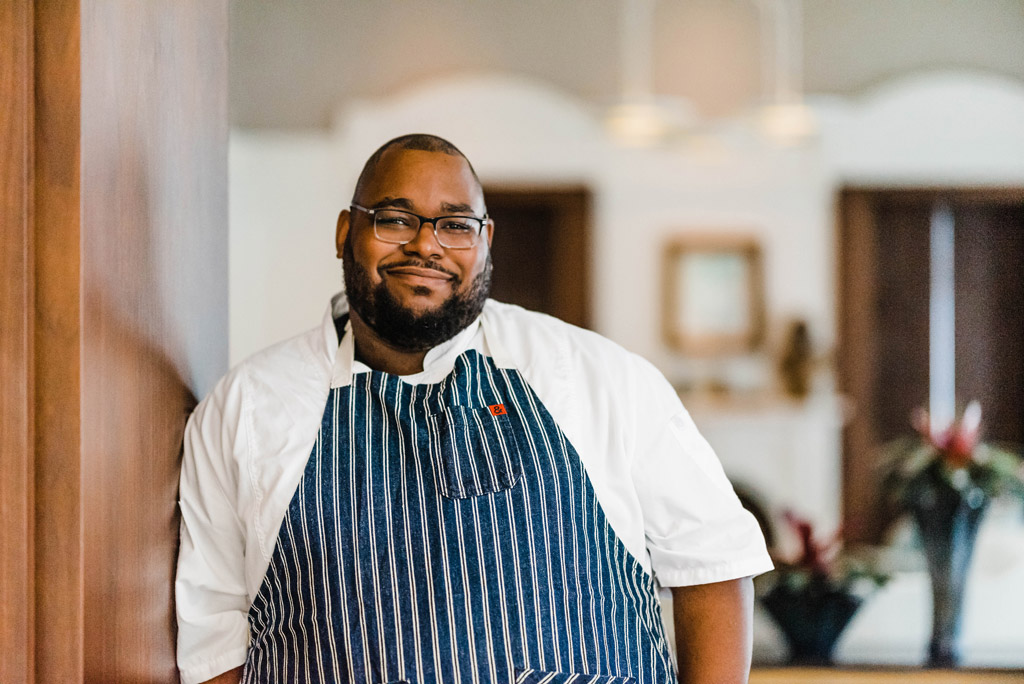
Okan is a celebration of what the African people were able to bring with them when they were torn away from their homes. It’s a story of spices, ingredients and techniques that began in Africa but spread with her people across the Americas, creating new culinary traditions from recipes passed down through generations.
Bluffton’s newest destination restaurant, Okan tells story of culinary traditions that cross generations and oceans.
There are few bad seats in Okan, a gorgeous side effect of its wraparound layout spanning the corner of Calhoun and Bridge Street. From nearly anywhere in the house, you can direct your gaze inward to the subtly metropolitan vibe inside, created by stark white walls and dark wood accents, or outside to the bustling sight of Calhoun street’s revamped southern end.

Okan is located on the corner of Calhoun and Bridge Streets, in Old Town Bluffton.
But perhaps the most illuminating seat can be found just to the right of the front entrance, a two-top table that lets your eyes wander across Calhoun as you dine. From this table, framed by the tastefully appointed trappings of Bluffton’s culinary renaissance, you can spy the Spanish moss billowing from the live oaks surrounding the Fripp-Lowden House, the crisp white railings of antebellum mansion Seven Oaks peering between branches. It’s a dazzling sight of Bluffton’s storied history, surrounded by the sophistication of its present.

But there’s a second story tucked away in this view. As stately and majestic as Seven Oaks is, as grand a sight as it presents to those passing along on Calhoun Street, one can’t help but wonder at its past. Those who have studied the town’s history know that parts of it were built in 1850, and while records are scarce, it’s more likely than not that more than a few people involved in its construction did so in the shackles of slavery.
It’s an intriguing juxtaposition to behold, seated in a restaurant that acknowledges that terrible chapter in our country’s history, but not with any hate in its heart. Okan is a celebration of what the African people were able to bring with them when they were torn away from their homes. It’s a story of spices, ingredients and techniques that began in Africa but spread with her people across the Americas, creating new culinary traditions from recipes passed down through generations.

Executive Chef Bernard Bennett
“I wanted to showcase the history of African American cuisine, because I don’t think what’s typically thought of as African American food is very representative,” said Executive Chef Bernard Bennett. “Stereotypically, you’d think of something like fried chicken, but they didn’t have fryers in Africa. I want to break that stereotype and showcase some of that historic food in my own expression.”
That historic food, thankfully, comes with a glossary for those of us who are expanding our palates like this for the first time. You might not know off-hand what merguez, pikliz, or djon- djon is—other than delicious—but reading about them helps you appreciate each ingredient’s role in the voyage this cuisine took. From Africa, it both influenced and drew influence from the Caribbean, traveling via the trans-Atlantic slave trade to New Orleans and Charleston, where it essentially defined Southern food as we know it.
“It’s food that shows the resiliency and the history of our people—not just African Americans, but everybody it’s touched,” Bennett said. “Because there are also touches of the people that colonized—heavy French influence, English influence … a heavy Spanish influence, it becomes an entire journey.”

And what a delicious journey it is.
Those who have followed the Okan food truck throughout Bluffton over the past year have been able to sample one leg of the trip, with mouthwatering rotis and rotating seasonal vegetables tossed in delectable peri-peri sauce, showing African cuisine’s Caribbean street food side. Stepping into the restaurant, however, you realize what a small part of that journey you’ve experienced. With a full kitchen to work with, Bennett has taken that same balancing act of respecting tradition and pushing boundaries to the next level. Some items, like the cashew curry resplendent with massive hunks of delicate lobster, take mainstream cuisine and show how it may have been prepared in Africa. Others, like the jerk goat, showcase the magic that occurred when African cooks met Caribbean ingredients.
“It’s not going to be one-for-one (African recipes), but it’s going to be fantastic food that shows the resiliency and the history of our people,” Bennett said. “Not just African Americans, but everybody that it’s touched, showcasing that through the slave trade from West Africa, through the Caribbean, to the Lowcountry and across America.”
The food beautifully (and deliciously) illustrates that journey, but like the layered view from the front window, there’s another journey just below the surface. It’s Bennett’s journey from his grandmother’s garden, sampling potatoes and green beans right from the earth, to the kitchens of Chicago and into his own concept here in the Lowcountry.
He’s honoring others on his culinary journey by giving back, helping black-owned farms build programs to serve more restaurants, and working to establish his place in the Lowcountry.
“I’m excited about the opportunity to be here, and I’m glad that the community has opened its arms to us,” Bennett said.
Okan is located at Calhoun and Bridge in Old Town Bluffton. For more information, visit okanbluffton.com.

The Dining Room at Okan is bright, with sleek lines and a distinctly metropolitan vibe. The view is the laid-back atmosphere of Bluffton’s downtown.


